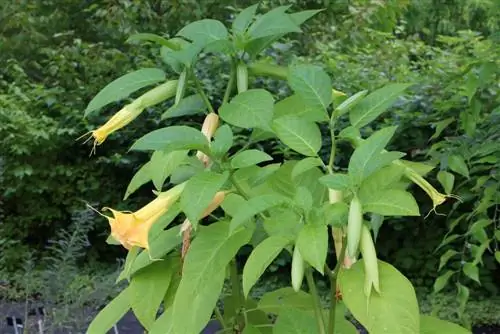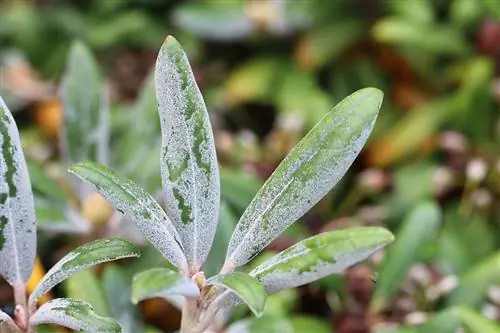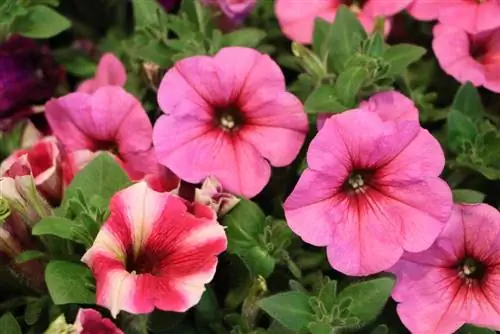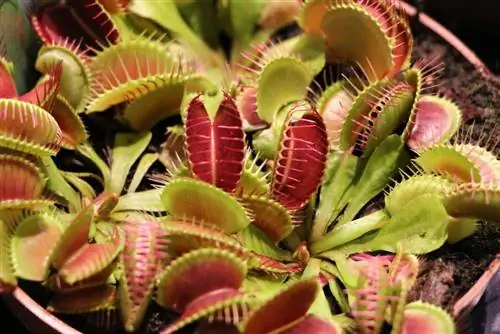- Author admin [email protected].
- Public 2023-12-17 03:39.
- Last modified 2025-06-01 06:48.
Angel trumpets (Brugmansia) from the nightshade family are among the particularly impressive ornamental plants. They grow as shrubs or even trees and can reach heights of up to five meters. These beauties originally come from South America and love warmth and sun. The sensitive plants are usually not hardy because they can only tolerate sub-zero temperatures poorly or not at all. There are many different cultivated forms of Brugmansias available on the market, including those that can overwinter in the garden in certain regions and at selected locations. Brugmansia Candida or Brugmansia Aurea are considered robust plants and are suitable (although only to a limited extent) for year-round gardening. These are usually strong, adult specimens that are generally less sensitive. With the following advice and tips you can successfully get an angel trumpet through the winter.
Properly prepare angel trumpet for hibernation
The Brugmansias are usually cultivated in a pot and decorate terraces or front gardens. Some hobby gardeners plant angel trumpets directly in the garden during the frost-free period, which is also good for the plants. The right location for an angel's trumpet in summer is sunny to partially shaded and preferably protected from the wind. Even light night frost can harm the sensitive plant, so it should move to its winter quarters beforehand. Preparing for hibernation involves, above all, reducing the amount of water. Of course, things get a little complicated with plants that are outdoors. In order to protect the angel's trumpet from heavy rain, it is worth repotting the plant in a pot two or three weeks before you finally move it into the house and placing it protected from the rain. The suitable location can be a covered terrace or a carport. Here the Brugmansia continues to be watered, but more and more sparingly. During this time, the angel's trumpet only needs a little fertilizer; fertilization can actually be stopped from mid-August - early September. The second important preparation measure for overwintering is pruning. Angel trumpets can tolerate radical pruning, so there is no need to worry too much in this regard. Basically, it is best to cut 20 to 30 cm above the first natural fork. The rule is: the shorter the pruning, the later the plant will start to bloom again in spring. On the other hand, pruning the angel's trumpet, like many other plants, has a strengthening and rejuvenating effect. 1. Tip: Cut branches are good material for propagating the angel trumpet. All you need to do is carefully insert the branches into the ground. 2nd tip: To prevent the cut from “bleeding”, it is advisable to cut the plant when it is still (relatively) warm. In the cold, the sore spot heals only slowly and the angel's trumpet can be damaged.
Winter quarters - cool but bright
The beautiful plant prefers to overwinter in a cool place. The range of the comfortable temperature is between +5°C and +10°C. At temperatures above +18°C, the plant continues to grow in winter, but is weakened as a result. The general lack of light in winter leads to the rotting of new shoots that form during overwintering in a place that is too warm, so these must be cut off in spring. An optimal overwintering place is an unheated winter garden in which the plant is placed in a pot in a partially shaded corner. Too much light, for example in February-March, can cause the plant to sprout too early. This also weakens the angel's trumpet, so that it either doesn't bloom until late in the summer or doesn't bloom at all. The question arises as to whether the Brugmansias also grow in the dark, e.g. B. can overwinter in a cellar. Hibernation without light is possible, but it is always only the second best solution. The problem is: Young plants in particular are weakened by overwintering in the dark and are vulnerable to pests.
Watering and fertilizing in winter?
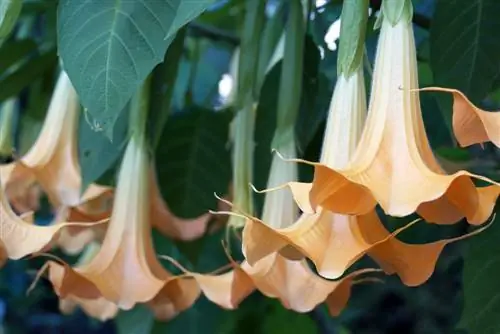
Angel Trumpet is in hibernation and resting before the next season. But that doesn't mean that the plant doesn't have any needs during this time. However, fertilizing is unnecessary in winter; adding a flowering plant fertilizer can only be started in spring. Angel trumpets also like nettle manure and thrive thanks to this fertilizer. In winter you should only water sparingly. It is important to ensure that the root ball does not dry out. Too intensive watering in winter leads to root rot, too little water causes the plant to dry out and leads to branches dying.
Pests in winter - always be on the lookout
In general, the plant is less susceptible to pests in winter. But it's worth staying vigilant and checking the angel's trumpet regularly for infestation. The plant can be attacked by spider mites, especially in dry conditions. A remedy to combat aphids, among other things, helps against this. An infestation by black weevils is very unpleasant; its larvae can be controlled by adding nematodes. Tip: Plants that overwinter without leaves offer pests less tempting food and therefore remain largely free of infestation.
Important Notice
These effective flowering plants are poisonous in all their parts. It is therefore advisable to wear gardening gloves, especially when repotting and cutting!
Wintering of angel trumpets soon
- The plant is only very hardy to a limited extent
- Cut back briefly in autumn and let the plant overwinter without leaves
- Angel trumpet prefers to overwinter in a cool but bright place
- In winter, water only moderately and do not fertilize
- Check regularly for pest infestation
Angel trumpet is one of the plants that overwinteres most safely in a room. These shrubs need a cool and relatively bright place and little water during their winter rest period. With proper care, they sprout well in spring and delight gardeners with their magnificent flowers.
Overwintering the Angel's Trumpet
Overwintering angel's trumpetsThe angel's trumpet is not hardy and must therefore be brought into a frost-free room for overwintering before the first night frosts in autumn, which can be either light or dark.
A bright room with a temperature of around 10 °C is best suited for the angel's trumpet to overwinter successfully. There it should not be fertilized and watered very sparingly so that it does not dry out completely. If there is no bright, cold place available, the angel's trumpet can also overwinter in the basement or another dark room. However, it is to be expected that the plant will only sprout late and bloom again. Basically, the darker the room for overwintering, the lower the temperature should be, which is why the angel's trumpet needs a temperature of around 5 °C in a dark room. An angel's trumpet can also spend the cold season in the winter garden, but it should not be kept warmer than 15° to 18° C so that it can take a break from growth. It needs as much light as possible and then continues to bloom for a while.
Care after successful wintering
From February, the angel's trumpet can be placed in a bright and warm place so that it can sprout again and begin to bloom early. Then the first flowers may appear as early as May. In spring it should then be cut back to half its height. A similar pruning must then be carried out on other potted plants, such as olive trees, lemon trees or orange trees. If space is tight, this cut can also be done when clearing up in the fall. However, in the case of an angel's trumpet that overwinters in the cellar, the cut surface may continue to bleed after the cut if it is immediately brought into the cellar. Therefore, in this case it should remain on the terrace for a few days until the cuts have dried.
Cutted shoots can be used to propagate an angel's trumpet by simply sticking them into the ground or potting soil to root them. The plant itself can also be repotted into a larger planter in spring. It quickly grows very large and needs a bucket that is appropriately heavy so that it doesn't fall over in the wind. As with the lemon tree, you should avoid repotting too often.
The angel's trumpet can be put back in the garden from mid-May, but it should not be placed in the sun immediately so that its leaves do not burn. It should be protected especially from the midday sun.

